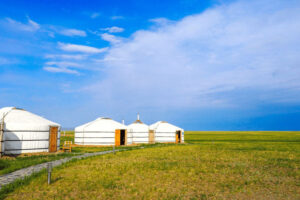Travel Advice
Things to know when traveling in Mongolia
Accommodations

A hotel room
In Mongolia, travelers can choose from a variety of accommodation types, including hotels in Ulaanbaatar, tourist ger camps in the countryside, and stays with nomadic families. Hotels in Ulaanbaatar range from budget-friendly to luxury options, while ger camps offer a more immersive cultural experience with traditional yurts. Staying with nomadic families provides a unique opportunity to learn about their way of life.
- Hotels in Ulaanbaatar:
Ulaanbaatar offers a wide selection of hotels, from budget-friendly to luxury, with amenities like restaurants, bars, and various room types (single, double, deluxe)

A ger camp
Tourist Ger Camps:
These camps are the most common type of accommodation outside Ulaanbaatar, featuring traditional gers (yurts) furnished with beds, a stove, and small tables. Some ger camps have upgraded gers with attached bathrooms. They also typically have a central building with a restaurant, showers, and toilets.
- Nomadic Family Stays:
Staying with nomadic families provides a more authentic cultural experience, allowing travelers to participate in daily activities and learn about their traditions.
- Camping:
Camping is another option, particularly for those seeking closer proximity to nature, but it requires carrying all necessary camping equipment.
Transportation
Transportation in Mongolia for travelers includes a mix of options, from domestic flights and the Trans-Mongolian railway for longer distances to buses, taxis, and 4WD vehicles for exploring the vast countryside. In Ulaanbaatar, taxis and public buses are readily available, while domestic flights can efficiently connect you to various regional centers.
Urban Transportation in Ulaanbaatar:
- Taxis:

Taxis in Ulaanbaatar
Readily available, but it’s recommended to agree on the fare before starting your journey.
- Public Buses:
An affordable option for navigating the city, though schedules can be irregular.
- Taxi Apps:
UBCab and ABA taxi are popular taxi apps with English menus for Ulaanbaatar.
Transportation Beyond Ulaanbaatar:
- Domestic Flights:
MIAT and Hunnu Air operate flights to various regional centers, including those near the Gobi Desert, Lake Khuvsgul, and the Altai Mountains.
- Buses:
A more budget-friendly option for intercity travel, but journeys can be lengthy and involve archaic Russian models.
- Train:
The Trans-Mongolian Railway offers a connection between Russia and China, passing through Ulaanbaatar.
- 4WD Vehicles:
Renting a 4WD with a driver is a popular choice for exploring the vast countryside and unpaved roads.
- Horse Treks:
For a more immersive experience, multi-day horse treks can be arranged in provinces like Arkhangai, Khuvsgul, and Khentii.
Tips for Traveling in Mongolia:
- Prepare for the unexpected:
Mongolian roads, particularly in rural areas, can be challenging, and breakdowns can occur.
- Consider a driver:
If you’re not comfortable navigating unpaved roads, hiring a driver can be a good option.
- Learn some basic Mongolian phrases:
While English is spoken in tourist areas, knowing some basic Mongolian can be helpful.
- Respect local customs:
Be mindful of local customs and traditions, and always ask for permission before taking photos of people or entering their homes.
Food and beverage

European Foods
Mongolian cuisine is characterized by hearty, meat-based dishes, dairy products, and flavorful soups. Travelers should try staples like buuz (steamed dumplings), khuushuur (fried meat pastries), and tsuivan (stir-fried noodles). Don’t miss out on khorkhog, a traditional barbecue cooked with hot stones, and boodog, a unique dish where meat is cooked inside the animal’s skin with hot stones. For a taste of nomadic life, sample airag, fermented mare’s milk, and various dairy products like aaruul (dried curds).
Traditional drinks include airag (fermented mare’s milk) and suutei tsai (salted milk tea).
Meat Dishes:

Mongolian Cuisine
Buuz: These steamed dumplings, often filled with mutton or beef, are a staple in Mongolian cuisine and are a must-try for any visitor.
- Khuushuur: Similar to buuz, but fried, khuushuur are a popular snack, especially during festivals like Naadam.
- Tsuivan: This stir-fried noodle dish with meat and vegetables is a common household meal in Mongolia.
- Khorkhog: This is a traditional barbecue, where mutton is cooked in a pot with hot stones and vegetables, creating a flavorful stew.
- Boodog: A more elaborate dish, boodog involves cooking meat, often goat or marmot, with hot stones inside the animal’s skin.
- Chanasan Makh: Simply boiled meat, usually mutton, often with potatoes, carrots, and cabbage, is a staple dish that allows you to savor the natural flavor of the meat.
Dairy Products:
- Airag: Fermented mare’s milk, a refreshing and slightly alcoholic drink, is a staple for nomads and a unique Mongolian beverage.
- Aaruul: Dried milk curds, a common snack and a part of the “white food” (dairy) tradition in Mongolia.
- Urum: Clotted cream, a rich dairy product often enjoyed with bread or boortsog.
Soups and Other Dishes:
- Guriltai Shul: A noodle soup with meat and vegetables, a hearty and nutritious option.
- Bantan: A meat porridge, a simple yet satisfying dish often enjoyed as a hangover cure.
- Boortsog: Mongolian fried cookies, often served with tea or as a snack.
Tips for Travelers:
- Accept food and drink with your right hand. It’s considered polite and respectful.
- Be open to trying new things. Mongolian cuisine is diverse, and many dishes are made with unique ingredients and cooking methods.
- Consider visiting a ger camp to experience authentic Mongolian food and hospitality.
- Inform your guide or host about any dietary restrictions
What is Mongolian currency?

Mongolian Tugrug
The local currency is called the Tugrug (MNT). As of October 2025, the exchange rate is about 3600 Tugrugs to the USD. The preferred foreign currency for exchange purposes is USD or Euro, but Pounds Sterling, Russian Rubles, and Chinese RMB can also be exchanged in many places in Ulaanbaatar. If you bring US dollars, make sure the notes were printed after 1996 (the large heads rather than the small ones). 50 dollar and 100 dollar notes will get a better exchange rate than smaller notes. Some exchange facilities are open 24/7. We recommend changing money only in banks, hotels, and exchange facilities. Credit cards are widely accepted in Ulaanbaatar but the countryside is cash-based society.
Discover MONGOLIA
Discover Untouched Nature
Discover Nomadic Culture
Discover Natural Contrasts
Discover Rich History







